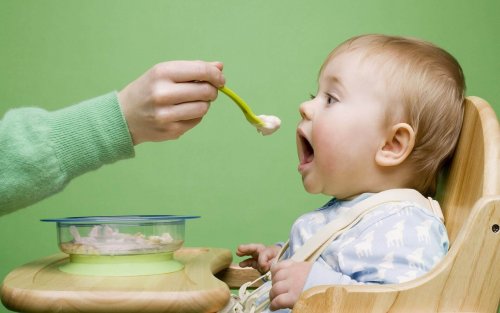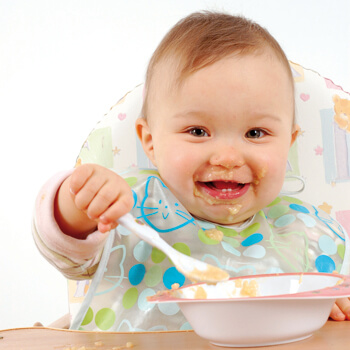Some Simple and Nutritious Recipes for Your Baby

Preparing homemade baby food is probably easier and more convenient than you might think. Furthermore, in addition to making sure your child eats healthy food, you’ll also save a lot of money on convenience foods. The key is in choosing fresh and healthy ingredients.
As your child begins to eat solids, making meals will become easier. In fact, you can simply puree the same recipes you prepare for the rest of the family.
That’ll save you time, as your baby will adjust to your own eating routines.
Some simple homemade baby food recipes
Pea puree
Peas are full of vitamins A, C, iron, calcium and are an excellent source of protein. Simply cook them until soft and mash them to a creamy texture. Be sure to pass the peas through a sieve if your baby isn’t used to textures yet.
From the age of 6 months it’s necessary to supplement breast milk by adding other foods because this alone is not enough to cover nutritional needs. In addition, from a psycho-motor point of view, this is the time when they are ready to learn to eat solid foods.
-Ministry of Health of Argentina-.
Mashed banana
This is considered the ‘perfect food’ in the early stage of a baby’s diet. Bananas are full of potassium, fiber, and are also gentle on a stomach that’s unused to solid food. In addition, according to a study published in the journal, Alimentary Pharmacology and Therapeutics, fiber intake helps to progressively increase the biodiversity of the intestinal microbiota.
However, avoid overdoing it with this food to avoid constipation. To prepare, peel the banana, mash it with a fork, and add some breast milk or formula.

Rice cereal
Rice cereal for babies is one of the most recommended foods because it’s non-allergenic. It’s also easy to digest and its smooth texture allows for an easy transition between liquid and solid diets.
To prepare it, you need three tablespoons of brown rice and one cup of water. First, you must put the uncooked rice in a blender or food processor until you obtain a fine powder. Then, mix it with the water in a pot and put it on the heat until it boils.
At the end of the process, it should have a creamy consistency. You can add more water or more rice, depending on the baby’s age.
Avocado puree
Avocado is considered a healthy source of fat that contributes to a baby’s physical and brain development. It contains folate, fiber, potassium, vitamin C, and iron.
To make it, mash an avocado with a fork or food processor and then add water or breast milk.
Carrot puree
Carrot provides antioxidants and vitamins, especially vitamin A. To prepare the puree, peel the carrots, cut them into chunks, and cook them in water or unsalted chicken broth.
Wait until they’re soft and mushy, let them cool, and mash them. The amount of liquid you add depends on the consistency you want.

Serving and storage recommendations
- When preparing homemade food for your baby, always make sure it’s not warmer than their body temperature.
- If you’re going to cook food in the microwave oven, check that there are no areas that are hotter than others. To avoid mistakes, let it rest for a while before eating it or giving it to your baby.
- Put only small amounts of food on the plate. In fact, only what you think your baby will eat. Because leftover food tends to accumulate bacteria due to its contact with saliva.
- Avoid adding sweeteners to the food you prepare for your baby. Little ones don’t need extra amounts of sugar. Also, don’t use honey as it may contain bacteria that can cause botulism.
- Ingredients that you don’t use when cooking your recipe can be frozen and stored for a few days. Fruits and vegetables can even last for months if you store them correctly.
- Remember to wait until your baby is four to six months old before offering solids. During this stage, there are physiological developmental signs that indicate that your baby is ready for a change in feeding.
- Another option is to let your child handle solid foods on their own so they can get used to their texture and taste. According to a study published in 2018, this technique helps reduce food refusals in the future.
Complementary feeding, an important step in development
As you can see, homemade baby food is extremely easy to prepare. It’s also safer than buying ready-to-eat food and you’ll be completely sure of the quality of all the nutrients you’re providing for your baby.
Remember to offer your child a variety of foods. As a matter of fact, good food education in the early stages of life reduces rejection later in life. In addition, diversity in terms of food exposure reduces the risk of developing autoimmune diseases.
Preparing homemade baby food is probably easier and more convenient than you might think. Furthermore, in addition to making sure your child eats healthy food, you’ll also save a lot of money on convenience foods. The key is in choosing fresh and healthy ingredients.
As your child begins to eat solids, making meals will become easier. In fact, you can simply puree the same recipes you prepare for the rest of the family.
That’ll save you time, as your baby will adjust to your own eating routines.
Some simple homemade baby food recipes
Pea puree
Peas are full of vitamins A, C, iron, calcium and are an excellent source of protein. Simply cook them until soft and mash them to a creamy texture. Be sure to pass the peas through a sieve if your baby isn’t used to textures yet.
From the age of 6 months it’s necessary to supplement breast milk by adding other foods because this alone is not enough to cover nutritional needs. In addition, from a psycho-motor point of view, this is the time when they are ready to learn to eat solid foods.
-Ministry of Health of Argentina-.
Mashed banana
This is considered the ‘perfect food’ in the early stage of a baby’s diet. Bananas are full of potassium, fiber, and are also gentle on a stomach that’s unused to solid food. In addition, according to a study published in the journal, Alimentary Pharmacology and Therapeutics, fiber intake helps to progressively increase the biodiversity of the intestinal microbiota.
However, avoid overdoing it with this food to avoid constipation. To prepare, peel the banana, mash it with a fork, and add some breast milk or formula.

Rice cereal
Rice cereal for babies is one of the most recommended foods because it’s non-allergenic. It’s also easy to digest and its smooth texture allows for an easy transition between liquid and solid diets.
To prepare it, you need three tablespoons of brown rice and one cup of water. First, you must put the uncooked rice in a blender or food processor until you obtain a fine powder. Then, mix it with the water in a pot and put it on the heat until it boils.
At the end of the process, it should have a creamy consistency. You can add more water or more rice, depending on the baby’s age.
Avocado puree
Avocado is considered a healthy source of fat that contributes to a baby’s physical and brain development. It contains folate, fiber, potassium, vitamin C, and iron.
To make it, mash an avocado with a fork or food processor and then add water or breast milk.
Carrot puree
Carrot provides antioxidants and vitamins, especially vitamin A. To prepare the puree, peel the carrots, cut them into chunks, and cook them in water or unsalted chicken broth.
Wait until they’re soft and mushy, let them cool, and mash them. The amount of liquid you add depends on the consistency you want.

Serving and storage recommendations
- When preparing homemade food for your baby, always make sure it’s not warmer than their body temperature.
- If you’re going to cook food in the microwave oven, check that there are no areas that are hotter than others. To avoid mistakes, let it rest for a while before eating it or giving it to your baby.
- Put only small amounts of food on the plate. In fact, only what you think your baby will eat. Because leftover food tends to accumulate bacteria due to its contact with saliva.
- Avoid adding sweeteners to the food you prepare for your baby. Little ones don’t need extra amounts of sugar. Also, don’t use honey as it may contain bacteria that can cause botulism.
- Ingredients that you don’t use when cooking your recipe can be frozen and stored for a few days. Fruits and vegetables can even last for months if you store them correctly.
- Remember to wait until your baby is four to six months old before offering solids. During this stage, there are physiological developmental signs that indicate that your baby is ready for a change in feeding.
- Another option is to let your child handle solid foods on their own so they can get used to their texture and taste. According to a study published in 2018, this technique helps reduce food refusals in the future.
Complementary feeding, an important step in development
As you can see, homemade baby food is extremely easy to prepare. It’s also safer than buying ready-to-eat food and you’ll be completely sure of the quality of all the nutrients you’re providing for your baby.
Remember to offer your child a variety of foods. As a matter of fact, good food education in the early stages of life reduces rejection later in life. In addition, diversity in terms of food exposure reduces the risk of developing autoimmune diseases.
All cited sources were thoroughly reviewed by our team to ensure their quality, reliability, currency, and validity. The bibliography of this article was considered reliable and of academic or scientific accuracy.
- Simpson HL., Campbell BJ., Review article: dietary fibre – microbiota interactions. Aliment Pharmacol Ther, 2015. 42 (2): 158-79.
- Andries Arantes AL., Silva Neves F., Lombelo Campos AA., Pereira Netto M., The baby led weaning method in the context of complementary feeding: a review. Rev Paul Pediatr, 2018. 36 (3): 353-363.
This text is provided for informational purposes only and does not replace consultation with a professional. If in doubt, consult your specialist.








